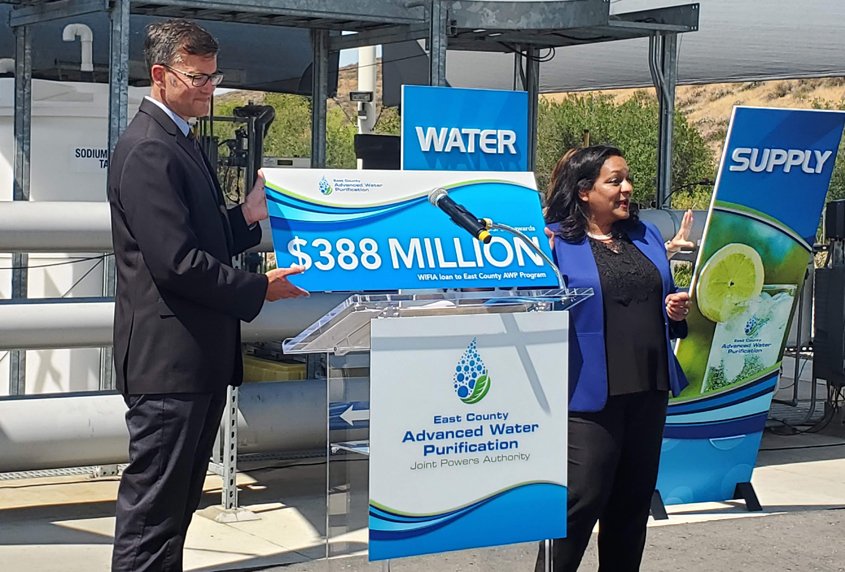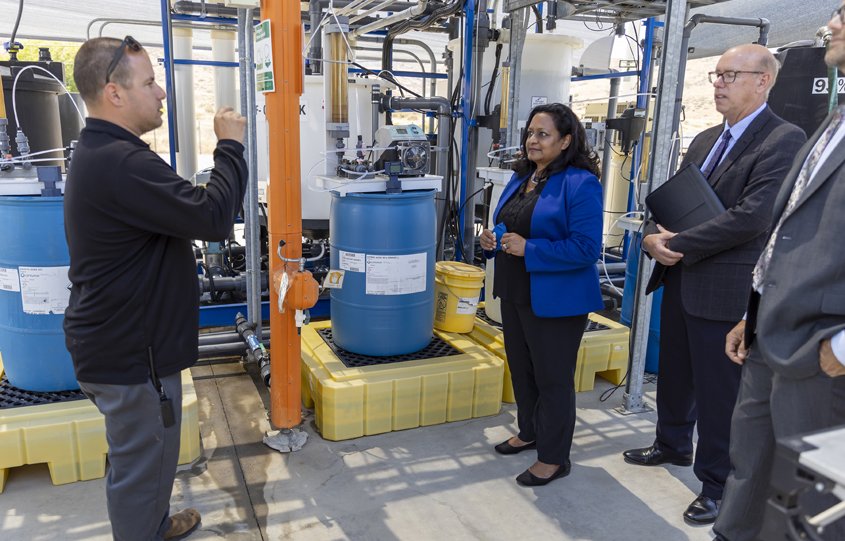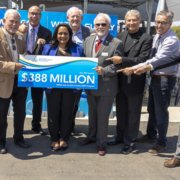In a major milestone for water reliability, the East County Advanced Water Purification Program was awarded a $388 million federal loan from the U.S. Environmental Protection Agency to help advance the project’s completion.
Radhika Fox, U.S. EPA Principal Deputy Assistant Administrator for the Office of Water, joined Kyle Swanson, Director of the East County AWP, and Steve Goble, Joint Powers Authority Chair of the East County AWP, for the June 4 announcement at the demonstration facility for the project in Santee. Following the presentation, Fox joined local officials for a tour of the demonstration facility.
“EPA is proud to partner on this project, which uses proven technology to bolster drinking water supplies in this climate-stressed region,” said Fox. “Investing in water infrastructure is one of the best bets we can make to improve public health and the environment, create jobs and address pressing challenges that face our communities.”

Radhika Fox (right), EPA Principal Deputy Assistant Administrator for Water, and Kyle Swanson, East County AWP Director. Photo: East County AWP
The East County AWP is one of only 38 projects selected nationwide to receive a share of approximately $6 billion in federal water infrastructure investments. The Water Infrastructure Finance and Innovation Act (WIFIA) loan is the second-largest loan awarded to any San Diego County project.
“The East County Advanced Water Purification Program is the result of many years of strategic, long-term planning and this WIFIA loan marks a historic milestone in its development,” said Allen Carlisle, CEO and general manager of Padre Dam Municipal Water District. “By providing East County with local control and independence of both its wastewater and water, the program secures a long-term solution for increased stability in our communities and safeguards the vitality of our economy and quality of life. We are grateful to the U.S. EPA for partnering with us on this important program and investing in future generations.”
New, local, sustainable water supply

Radhika Fox of the EPA tours the East County Advanced Water Project Demonstration Facility in Santee. Photo: East County AWP
The East County AWP is a collaborative partnership between the Padre Dam Municipal Water District, Helix Water District, County of San Diego, and City of El Cajon. It will create a new, local, and sustainable drinking water supply using sophisticated technology to provide 30% of current drinking water demands for East County residents when it is completed in 2025, as much as 11.5 million gallons per day.
The project will recycle East San Diego County’s wastewater locally and purify the recycled water at a new treatment facility using four advanced water purification steps. The purified water will then be pumped into Lake Jennings, treated again at the Helix Levy Treatment Plant, and then distributed into the drinking water supply.
Padre Dam Municipal Water District currently imports 100% of its drinking water supply. The agency treats two million gallons per day at its water recycling facility for irrigation and non-potable uses. Helix Water District imports approximately 85% of its drinking water supply with the remaining coming from local sources.
In addition to providing a new local water supply, the project will eliminate the need to send most of East County’s wastewater to the City of San Diego’s Point Loma Wastewater Treatment Plant, where it is currently treated and then discharged into the ocean. Keeping this water resource in east county provides water sustainability and it’s good for the environment.
(Editor’s note: The Padre Dam Municipal Water District, Helix Water District, and the City of El Cajon are three of the San Diego County Water Authority’s 24 member agencies that deliver water across the metropolitan San Diego region.)





